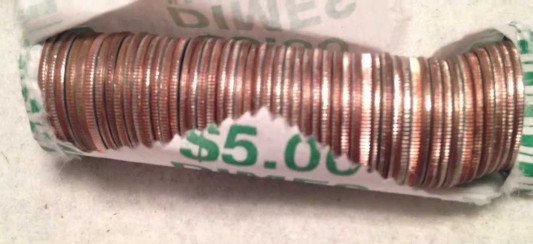

Was specially: Coin roll hunting uk
| CAMPING CAR INTEGRAL OCCASION LE BON COIN | |
| Cheap gold and silver coins | 31 |
| Coin roll hunting uk | |
| Coin roll hunting uk |
Coin roll hunting

Coin roll hunting (often abbreviated as CRH) is the hobby of searching and sorting coinage pulled from circulation for collectible coins. This is achieved through obtaining rolled coin, boxed coin, or bagged coin from banks and credit unions. A variant of this practice involves banknotes and is carried out in essentially the same fashion, normally to search for unusual serial numbers, star notes and misprints.
Coin roll hunting in the United States[edit]
In the United States, coin roll hunters obtain rolls of cents, nickels, dimes, quarters, halves, and sometimes dollar coins.
Prime targets of American coin roll hunters are silver dimes, quarters, and halves prior to 1965, and 40% silver half dollars from 1965-1970.[1] Nickels are searched for 35% silver "war nickels" (1942–1945) older discontinued designs such as the Buffalo and "V" Nickel are also collected.[2] Cents are also searched for older designs such as wheat cents (1909–1958), steel cents (1943) and Indian head cents (1859–1909) and some searchers save copper Lincoln cents 1959–1982 for the growing value as copper bullion. Toned coins are also of interest to collectors, and are occasionally found in coin rolls. An occasional darkly discolored or corroded dime can also be found in cent rolls, giving the collector an instant 10 fold bonus. Often coin roll hunters also collect special proof coins, exonumia, and coins from other nations. Others attempt to find and complete a set of coins, like the America the Beautiful Quarters, 50 State Quarters or Presidential Dollars, and some collect special issues such as the bicentennial quarters and halves (1976), bicentennial Lewis and Clark nickels (2004-2005), and bicentennial Lincoln cents (2009).[3] Specific dates of specific denominations that are rarer than others or minted in lower-than-usual quantities may also be taken from circulation, such as 1970, 1987, or 2002 to present halves, 2009 nickels and dimes, or 2002-2008 Sacagawea dollars. Some people search the rolls for error coins that have defects from the minting process and can be worth more than face value to collectors.
Coin roll hunting in Canada[edit]
In Canada, coin roll hunters obtain rolls of nickels, and sometimes dimes and quarters.
Dimes and quarters didn't have very high mint numbers until silver was discontinued in 1968. Coins after 1968 were then minted in very high numbers, making silver coins uncommon, plus the introduction of silver-rejecting bank machines took many silver coins out of circulation. This all made silver too hard to find for coin roll hunters, so they primarily search for 1922-1964 nickels for their numismatic value and for 1965-1981 Nickels for their metal value, which slightly exceeds their face value. Pre-1997[4]pennies were also pulled out of circulation due to their copper high metal value prior to the removal of pennies from circulation in 2013.[5] Other roll hunters attempt to build sets of special quarters, loonies, and toonies.
Merits as a means of making money[edit]
The merits of coin roll hunting as a means of making money are hotly debated. It is not uncommon for coin roll hunters to search through multiple boxes of coins only to find nothing of value. The amount of silver left in circulation is constantly dwindling, and this is ironically exacerbated by collectors finding and removing circulating silver from the rolls that they hunt. Many seasoned veterans of coin roll hunting have commented that in the long run they would have been better off just buying the silver coins they have found as it would have been cheaper and easier once the cost of their time has been factored in. The expected return from coin roll hunting also varies based on what denomination is searched. US quarters and dimes tend to produce the worst as most of the silver from these denominations has already been pulled from circulation. Cents provide the best returns when collecting pre-1982 copper cents with the typical cent roll producing around 20% copper to 80% zinc cents.[6] However, the amount of profit from searching cents is much lower due to the lower face value of the coin. When the US dollar is higher than the Canadian dollar, CRH enthusiasts often pull all the American coins to exchange or spend in the USA.
In the United States, it is illegal to melt down cents and nickels, so they cannot be legally redeemed for their metal content.[7]
Tracking sorted coins[edit]
Some coin roll hunters mark, paint or deface coins in order to identify that a batch of coins has been searched. This action is often frowned upon, however. If any of that hunter's mark (or the marks of other hunters) are found in a supply of coins, this is an indicator that said batch has already been searched. However, given the large amounts of coin circulating in the United States, marking searched coins is unlikely to be effective unless done on a large scale. Furthermore, it is often considered bad etiquette in the coin roll hunting community to deface coins with marks since the marked coins may be of some collecting value to other people. Defacing of coins is also illegal in some countries, such as Canada. In the United States, countermarking (aka counter stamping) of coins is legal under 18 USC Section 331 provided it is not done for the intent of committing fraud. This is also the legal basis for elongated pennies.
0 thoughts on “Coin roll hunting uk”